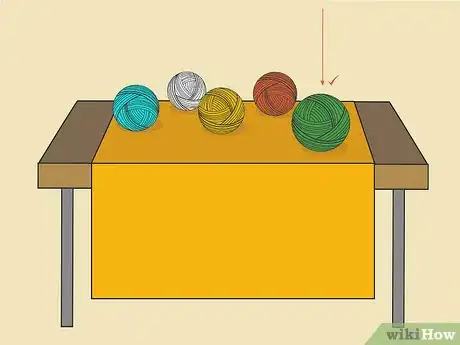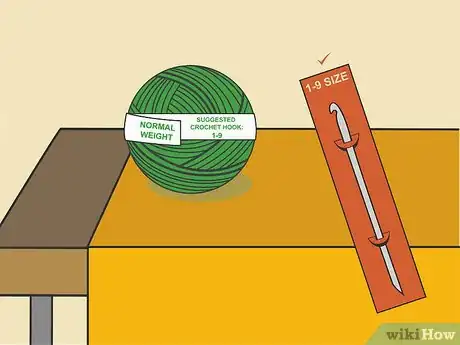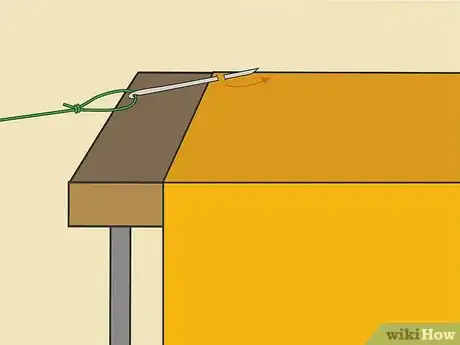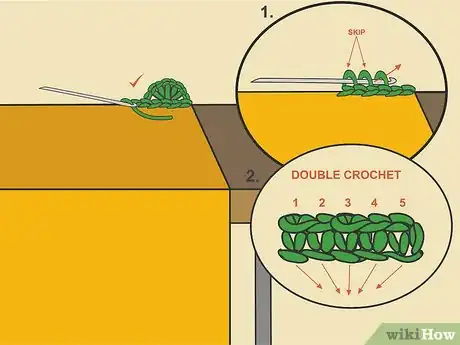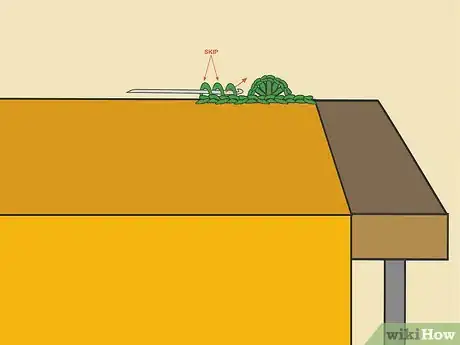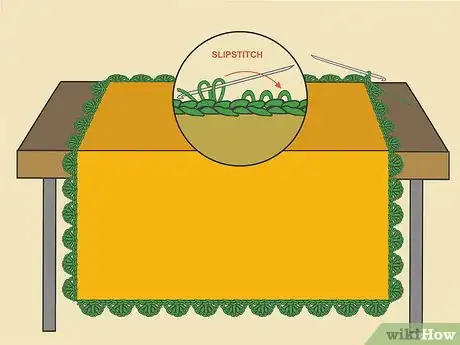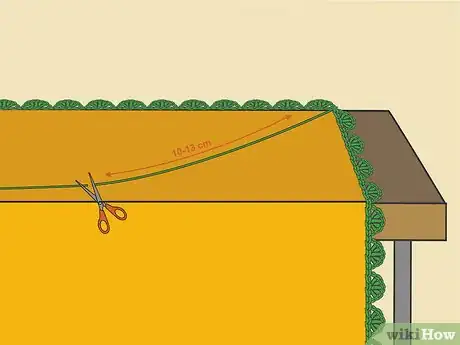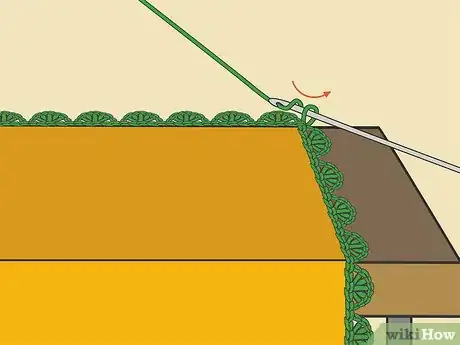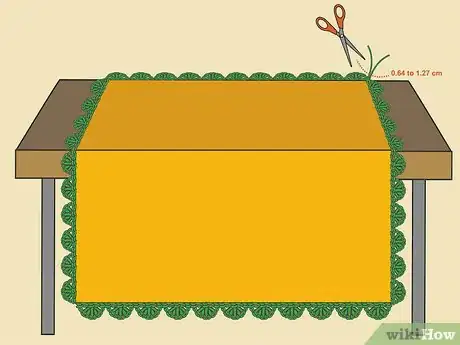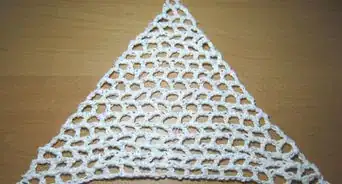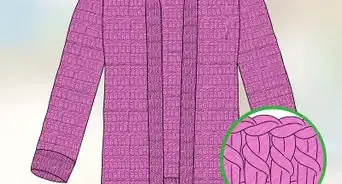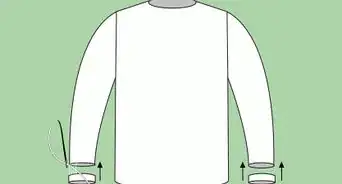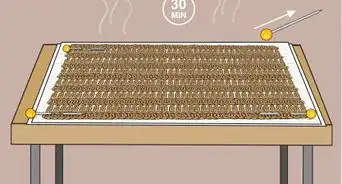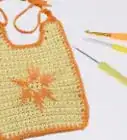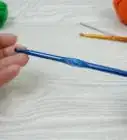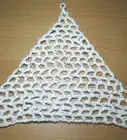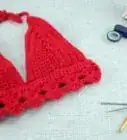This article was co-authored by wikiHow Staff. Our trained team of editors and researchers validate articles for accuracy and comprehensiveness. wikiHow's Content Management Team carefully monitors the work from our editorial staff to ensure that each article is backed by trusted research and meets our high quality standards.
There are 13 references cited in this article, which can be found at the bottom of the page.
This article has been viewed 26,341 times.
Learn more...
A scalloped border is a wavy edge that goes around the outside of an item. Scalloped borders add interest to crocheted and knit items, such as blankets, scarves, and hats. It is easy to add a scalloped border whether you are a beginner or expert knitter, so try adding one to a knit or crocheted item for a little extra flair!
Steps
Choosing Yarn and Beginning the Border
-
1Choose a matching or contrasting color yarn to use for a border. You can add a border onto a knit or crocheted item that is the same color as the item or that is a different color. Consider how much you want the border to stand out and what color would work best with the item.[1]
- For example, if you will be adding a border onto a baby blue blanket, then you may choose a baby blue yarn in the same shade, or opt for something that will contrast with the blanket, such as pale yellow, mint green, or white.
-
2Pick yarn that is the same weight as the item. For best results, make sure that the yarn is the same weight as the yarn that was used to knit or crochet the item. You can find the yarn weight listed on the package of the yarn, or just compare a strand of the yarn in your item with a strand in the yarn you'd like to use and see if they are roughly the same diameter.[2]
- For example, if the item is made from medium-weight yarn, then use a medium-weight yarn for the border.
Advertisement -
3Select a crochet hook that will work with the type of yarn you are using. Check your yarn’s label for a crochet hook size recommendation, or look it up online if you are unsure. Using the correct size hook for the yarn you have selected will help to ensure that you get the best results.[3]
- For example, if you are using a medium-weight yarn to create a scalloped border, then the recommended size may be a US size I-9 (5.5 mm).
-
4Slipstitch into the edge of the item. Identify where you want to work the first stitch on the border of your item. Then, make a slipknot and slide it onto your hook. Insert the end of the hook into the stitch where you want the border to begin. Then, loop the yarn over the end of the hook and pull it through both loops to anchor the yarn to your item.[4]
- If you plan to go all the way around the item, then you can start anywhere along the border.
- If you only plan to add a border to part of the item, decide where you want the border to begin and end.
Have a boring sweater you want to upgrade? Scalloped borders also look great on sleeves, necklines, and along the bottom hem.
Working a Basic Scallop Stitch
-
1
-
2Skip 2 stitches and double crochet 5 times into the same stitch. Do not work stitches into the first 2 stitches next to where you anchored the yarn. Go to the third stitch and then loop the yarn over the end of the hook 1 time. Insert the hook into the stitch, and yarn over again. Pull through 1, and then yarn over the hook again. Pull through 2, then yarn over again and pull through the last 2.[7]
- Repeat the double crochet stitch 4 more times into the same space.[8]
-
3Skip 2 stitches and slipstitch into the third stitch. After you complete the fifth double crochet stitch, skip the next 2 stitches. Then, work a slipstitch into the third stitch from where you worked the 5 double crochet stitches.[9]
Tip: If you want help keeping track of your stitches, download a stitch counting app. Then, simply tap the screen of your phone after you complete each stitch to help you keep track of what you have done so far.
-
4Repeat the sequence to continue adding scallops. Chain 1, skip 2 stitches, and then double crochet 5 times into the third stitch. Then, skip 2 stitches and slipstitch into the third stitch. Repeat this sequence to keep adding scallops onto the edges of your project.[10]
- You can create as many scallops as you like using this sequence.
Finishing the Border
-
1Finish the border with a slipstitch. Keep working until you have covered the desired section of your item. Then, work a slipstitch into the space between your first and last stitches if you are doing a full border, or after the last stitch if you are doing a partial border.[11]
- If you are doing a full border, do your best to position the last scallop and slipstitch so that the ends will be as evenly spaced as the rest of the item. However, don’t worry if you are 1 or 2 stitches off. It will not be noticeable.
-
2Cut the yarn 4 to 5 in (10 to 13 cm) from the last stitch. Use a sharp pair of scissors to cut the end of the yarn at this distance. It’s okay to estimate this length. It does not need to be exact. You just need enough yarn to easily pull the end through your last stitch.[12]
-
3Pull the end of the yarn through the loop on your crochet hook. Wrap the strand around the hook 1 time and then pull the end of the strand through the loop that is on the crochet hook. Bring the end of the strand all the way through the loop and tug the end until it is a tight knot.[13]
- This will secure the end of your border.
-
4Cut the loose ends 0.25 to 0.5 in (0.64 to 1.27 cm) from the border. You will have a tail at the beginning of your border and at the end of it. Cut each of these strands of yarn about 0.25 to 0.5 in (0.64 to 1.27 cm) from the last stitch. Do not cut the ends of your yarn any shorter than this or they may unravel.[14]
- Your border is complete after you cut the ends!
Want to try a different type of border stitch?
Go with a slipstitch or single crochet stitch for a simple border.
Try the double crochet or triple crochet to add width.
Opt for the shell stitch or petal cone edging for something fancy.
Community Q&A
-
QuestionHow do I put the edge on a cloth item?
 T. ChinsenTop AnswererAttach an edge by simply sewing it onto the fabric. Other options: blanket stitch the fabric, then crochet into the stitches. If possible, crochet directly into the fabric if using fine cotton. Knit fabrics have a stretch factor and will be more forgiving with any unevenness. Woven fabrics will amplify any errors or any uneven edges. With a yarn edging, use matching thread to attach it. Trying to sew with 4-ply thickness can create a bulky seam. Split a 4-ply strand and use 2 strands to sew and twist as you sew to strengthen the thread.
T. ChinsenTop AnswererAttach an edge by simply sewing it onto the fabric. Other options: blanket stitch the fabric, then crochet into the stitches. If possible, crochet directly into the fabric if using fine cotton. Knit fabrics have a stretch factor and will be more forgiving with any unevenness. Woven fabrics will amplify any errors or any uneven edges. With a yarn edging, use matching thread to attach it. Trying to sew with 4-ply thickness can create a bulky seam. Split a 4-ply strand and use 2 strands to sew and twist as you sew to strengthen the thread.
Things You’ll Need
- Yarn
- Crochet hook
- Scissors
References
- ↑ https://www.youtube.com/watch?v=3G2YLfyQGvs&feature=youtu.be&t=25
- ↑ https://www.craftyarncouncil.com/standards/yarn-weight-system
- ↑ https://www.craftyarncouncil.com/standards/yarn-weight-system
- ↑ https://www.youtube.com/watch?v=3G2YLfyQGvs&feature=youtu.be&t=30
- ↑ http://newstitchaday.com/crochet-101-how-to-crochet-the-chain-stitch-for-beginners/
- ↑ https://www.youtube.com/watch?v=stZ8_D6oLfw&feature=youtu.be&t=18
- ↑ https://newstitchaday.com/crochet-101-how-to-crochet-the-double-crochet-for-beginners/
- ↑ https://www.youtube.com/watch?v=stZ8_D6oLfw&feature=youtu.be&t=24
- ↑ https://www.youtube.com/watch?v=stZ8_D6oLfw&feature=youtu.be&t=50
- ↑ https://www.youtube.com/watch?v=stZ8_D6oLfw&feature=youtu.be&t=60
- ↑ https://www.youtube.com/watch?v=09SMKeliM9w&feature=youtu.be&t=40
- ↑ https://www.youtube.com/watch?v=09SMKeliM9w&feature=youtu.be&t=52
- ↑ https://www.youtube.com/watch?v=09SMKeliM9w&feature=youtu.be&t=67
- ↑ https://www.youtube.com/watch?v=09SMKeliM9w&feature=youtu.be&t=73
